There’s a reason that countless avid growers look forward to Rosella season, myself included. This globally celebrated hibiscus has a lot to offer and is now one of our most cherished and sought-after bush tuckers, predominantly for jam and tea making.
Featuring deeply lobed long leaves atop reddish stems highlighted by hibiscus-like creamy white to pale yellow blooms with spectacularly large red centres, this plant also produces deep-red to crimson fruits that have many culinary applications.
Overall, this plant can add effortless beauty to any garden regardless of size and setting. Here is your comprehensive guide to growing and caring for this fantastic flowering and fruiting species.
More...

Family: | Malvaceae |
|---|---|
Genus: | Hibiscus |
Species: | H. sabdariffa |
Common Names: | Rosella, rosella plant, roselle, wild hibiscus |
Location: | Outdoor |
Type: | Flowering subshrub |
Growth: | Up to 2.5 metres tall and wide |
Sun requirements: | Full sun |
Foliage Colour: | Green |
Flower Colour: | Creamy white |
Flowering: | Late summer to autumn |
Fruit: | Produces edible deep red fruits after flowering |
Maintenance level: | Low |
Poisonous for pets: | Non-toxic to cats and dogs |
Getting to Know the Rosella Plant
Considered a very hardy and productive addition to gardens, the rosella plant has the ability to produce fruits after about only six to eight months in good conditions, making it an excellent choice for those who are looking for a fast-growing fruiting plant for their landscapes.
Should you not be very interested in its fruits, rosella can still be a fantastic ornamental addition to your outdoor spaces as it features all-around decorative characteristics. Take advantage of this stunning species regardless of your skill level.
Hibiscus sabdariffa or rosella is originally native to tropical West Africa, India and Malaysia but has long since been naturalised in many other tropical and subtropical countries including Australia, occurring largely in the tropical north.
Hibiscus sabdariffa Plant Details
Part of the Malvaceae family of plants, this species prefers warmer climates so it’s a great fit for most of our endemic conditions. In cooler, more southern regions, container growing for overwintering is recommended.
Growth is considered rapid in good conditions where the plant will usually reach up to 2.5 metres tall and wide in cultivation, all within only about 6 months.
Common landscaping applications for the rosella plant include:
- Feature plant
- Hedging or screening (See our guide on Australian Native Hedge Plants)
- Fruiting specimen
- Container gardening
- Decorative bed filling
How to Grow Rosella Plant
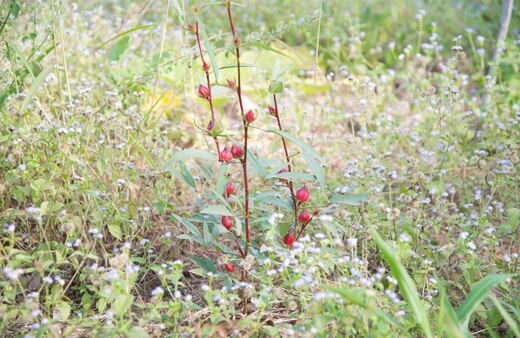
This plant is best propagated by seeds. Alternatively, establishing a few young and healthy tubestock plants with developed root systems is always a fast and reliable way to grow your very own rosella plant collection at home.
These young plants as well as fresh seeds will be available online or at your local Australian nurseries. Should you have access to a rosella plant already, you can collect viable seeds from matured fruits.
Be sure to keep a few calyces on the bush to mature when harvesting for seed collection later. Gather seeds once the fruits have completely dried out then store them for use next season.
Propagating Rosella from Seeds
- Sow your seeds in spring to early summer as rosellas need about 5 months of frost-free conditions to bear fruits. In southern areas of Australia, this could be as late as October outside.
- Prepare your garden bed by digging in some compost and well-rotted manure to enrich the planting location.
- If you’re concerned about your outdoor temperatures or you live in a cooler climate, seeds can be started indoors in seed trays for the best results.
- Create a planting hole that is around 1 cm deep and sow the seeds into the hole and cover lightly.
- If you’re planting several bushes outside, space the seeds about 1 to 2 metres apart.
- The ideal soil temperature is over 25°C as the warmer soil will highly encourage germination.
- Keep the soil moist until germination occurs.
- The young seedlings and plants will require frequent watering while they grow. This will ensure you have a large, productive bush with bountiful blooms in the coming months.
- Seedlings can be transplanted into the garden bed or containers when they have produced at least 4 to 6 leaves.
Related: Sowing Seeds vs Planting Seedlings: Which is Better?
Best Conditions for Growing Rosella Plant
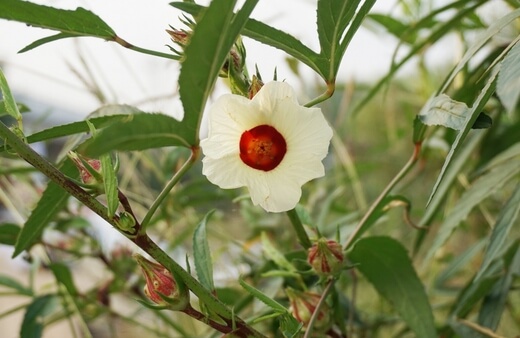
Planting in spring is ideal to ensure a good autumn harvest. Overall, these plants are very hardy and productive without much assistance and they can practically be grown almost anywhere in the garden.


Get Your Free Guide:
Master Growing Australian Natives eBook
A Must Have Complete Guide for Every Australian Garden
Get Your Free Guide:
Master Growing Australian Natives eBook
A Must Have Complete Guide for Every Australian Garden
Here are the basic growing requirements for a rosella plant to ensure good growth, more blooms and fruitful harvests.
Soil Needs
Most types of soil are suitable for rosellas provided the soil is rich and well-draining. Mulching the soil with an organic mulch around the base of the plant will also be beneficial in summer to ensure good moisture retention.
Ideal Exposure for Hibiscus sabdariffa
The growing location should always allow for plenty of full, direct sun. A little dappled light in the late afternoons should be fine but generally, rosella plants are not very tolerant to shade.
Container Growing
Treat container-grown bushes similarly to garden-grown plants. Use rich, well-draining soil and position the container in a sunny location. Be sure to use a large enough container as these plants are rapid growers.
Mass Planting for Good Yields
For great harvests and to allow the production of enough calyces to mature into fruits and also to leave on the bushes for seed collection for next season, it is highly recommended to establish 3 to 4 plants at a time.
Caring for Hibiscus sabdariffa
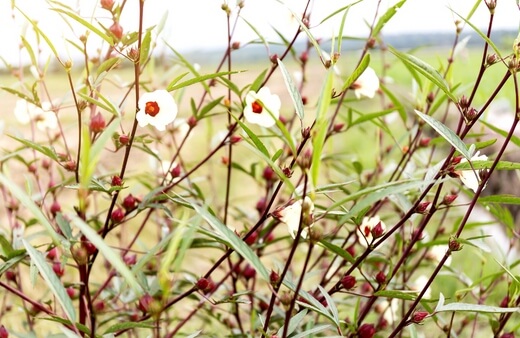
As with many fruiting and flowering plants, some extra care and attention can go a long way, especially during development. However, once established, these plants are hardy and very self-sufficient.
Watering a Rosella Plant
This is probably the most essential care component for rosella. This plant loves plenty of water to maintain growth and for flower and fruit development, especially in the hotter months when it is most active.
Overwatering should be avoided so you’ll need to assess what your plant needs based on its environment in your landscape. Use your finger to check when the soil is drying and water as needed.
If you experience decent rainfall, your rosella plant may not need as much supplemental watering.
Pruning Hibiscus sabdariffa
If your rosellas are productive and produce many branches, you can harvest a few leaves before flowering starts in autumn. These leaves make excellent and nutritious additions to stir-fries and fresh salads.
Lightly pruning the leaves in spring will also encourage quality yields. For maximum flower production, pruning should be kept to a minimum where you should trim only to control size.
Mulching a Rosella Plant
Regular mulching will be beneficial for your rosella’s overall health. Be sure to use an organic mulch and place it around the base of the plant but not directly on the stems.
See our ultimate guide on the best types of mulch for the garden here.
Avoiding Root Rot Issues
To avoid any rotting roots or stems, it is best to plant in a different part of your garden each year.
Rosella Plant – Bush Tucker Guide
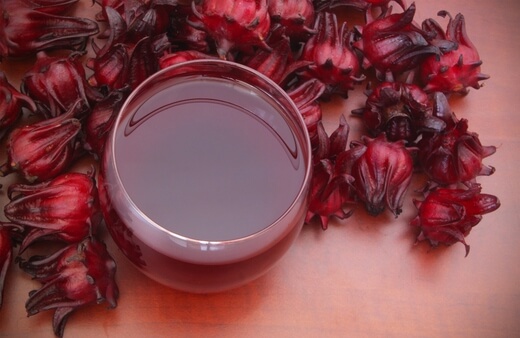
Your rosella bush will produce red edible calyxes after flowering that can be used as additions to many culinary dishes and drinks. These calyxes have a pleasant tart-sweet flavour profile, perfect for those who enjoy using harvested fruits in the kitchen. Not to mention they also look very appealing when ripe.
Traditionally, these fruits were used as a folk medicine as a diuretic and mild laxative whereas the leaves were commonly used as a spicier version of spinach. Even the stems were used for fibre so no part of these plants were wasted.
The petals, leaves and flower calyces are all considered edible and delicious. However, as with many bush tuckers, always see how your body reacts to the fruits and limit intake as needed to avoid possible irritations.
Another plant native to India and also used as a diuretic is the Withania somnifera. Check out our comprehesive guide to growing Ashwagandha plant to learn more.
Benefits of Rosella as a Bush Tucker
- Rosella is very high in vitamin C, reportedly 9 x stronger than orange.
- It is an easy-to-grow and fast-growing fruiting bush.
- It is a very hardy plant that is pest resistant.
- Fruits are a good source of natural protein.
- Fruits and flowers can help to reduce blood pressure.
How to Use Your Rosella Plant
Though the leaves and petals are also safe and tasty, the red calyxes are what are commonly used to make most of the commonly consumed rosella products. These fruits can even be found preserved at your local supermarkets.
Here are the most popular uses of rosella:
- The dried, cranberry-tasting calyces (fruits) are steeped in water to make a popular infusion called Carcade or Hibiscus Tea. This tea is prepared by boiling fresh, frozen or dried fruits for 10 to 15 minutes or until the water turns red. Add some sugar and serve chilled.
- The infused tea is also a popular addition to rum.
- The tasty, fleshy fruits go extremely well in salads, jams, jellies, red sauces, cordials, syrups and even baked goods like muffins and cakes.
- Young leaves can be streamed or stir-fried, commonly known as red sorrel.
- The jam has been made since colonial times and has a similar flavour to plum jam but is a little more acidic. Jams are made from the interior buds of the flowers with some sugar. Rosella jam is very popular in Queensland.
- Flowers and fruits can be added as a flavouring additive for cocktails, white wine and champagne.
- There are many other exciting and tasty recipes available online so be sure to do some research to find what you and your family will enjoy the most.
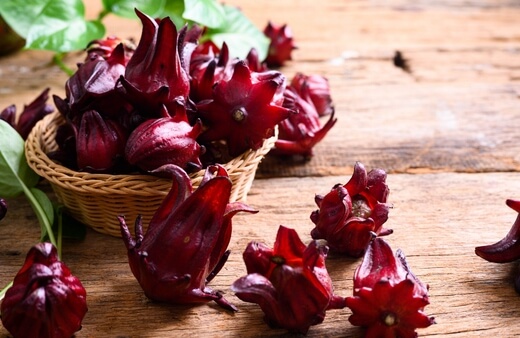
Harvesting Rosella Fruits
About a month after flowering, the large fleshy red calyces should be ready for harvesting. They should be crisp and bright red. Be sure to leave any damaged or mouldy fruits on the bushes.
The first harvest is normally underwhelming but the harvests will increase after the plant’s second flowering in autumn.
- You can simply snip the plumpest and healthiest calyxes straight off the bush.
- The flowers can be harvested when the petals start wilting and falling off the plant, leaving behind deep red-coloured calyces.
- Remove the large round seed pods at the centre then cut flowers at their bases using a pair of sharpened secateurs. (See our comparison of the best secateurs for 2023.)
- Push the pod through the petals with your finger.
- Seedpods should be kept if you’re making jam as they contain pectin. Otherwise, they can be discarded.
- Rinse flowers and fruits before cooking and allow them to dry a little on a towel or piece of paper towel.
- Remember to leave some fruits on the plant to dry out so you can collect the seeds for the next season.
Here are a few rosella recipes to help get you started:
Rosella Pests & Diseases
This hardy and well-adapted plant has very few reported pest or disease issues. In some regions, mealybugs and scale insects may infest stems and leaves. Sometimes aphids may also be present.
You can treat these minor pest issues with a horticultural soap spray, molasses spray or an organic neem oil spray for plants.
Caterpillars and beetles may also enjoy munching on the stems, leaves and calyces. You can control these pests by removing them by hand (usually at night while they’re most active) or by placing a white ice cream container or two around the bushes filled with detergent and water.
Empty and replace with fresh water and detergent as needed until the infestation is eradicated. Stem and root rot may become a problem due to overwatering.
Rosella Frequently Asked Questions
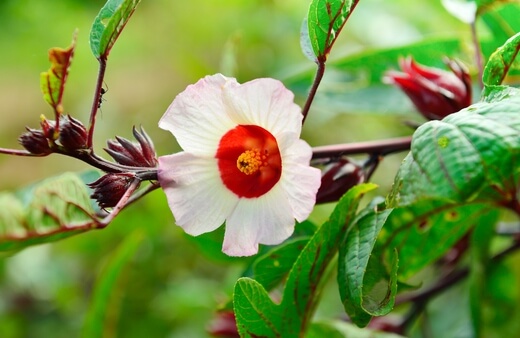
Why is my rosella dying?
This plant is considered an annual so it loves the heat. It is normal for these bushes to die back during winters, especially in cooler regions.
What are the side effects of hibiscus tea?
In sensitive individuals or by consuming too much rosella, some may experience a drop in blood pressure, headaches, nausea and slight ringing in the ears. Be sure to avoid hibiscus if you are allergic or sensitive to members of the Malvaceae plant family.
Do I need to prune my rosella?
While this plant may not need pruning at all once established, pruning after its first harvest in summer is recommended. Cut the bush back by one-third to encourage a bigger second harvest. Thereafter, only light trimming is needed to maintain size and appearance.
Why is my roselle not flowering?
Some varieties of rosella can be sensitive to day length and won’t flower if the days are longer than 13 hours.
Does hibiscus tea make you sleepy?
While hibiscus tea is caffeine free, the sleep-inducing effects are due to its anxiolytic and sedative properties.
Should you be interested in establishing Australian native hibiscus alongside your rosellas, be sure to check out our informative growing guide below for more helpful information:
- How to Grow Australian Native Hibiscus
Raise Your Gardens Appeal and Start Your Rosella Collection Today
Enjoy bountiful blooms and flavour-filled fruits with this notorious bush tucker, the rosella plant. Whether for its beauty, easy-going nature or productive fruiting and flowering, Hibiscus sabdariffa will always impress and easily boost the spectacle of any garden.
If you’re a bush tucker enthusiast looking for the perfect next addition to your summer garden, rosella is certainly a must-have.
Published on November 9, 2022 by Maisie Blevins
Last Updated on February 20, 2025




